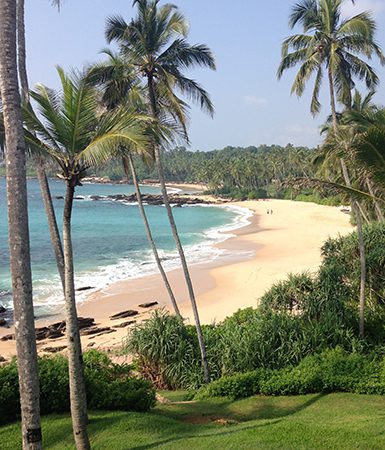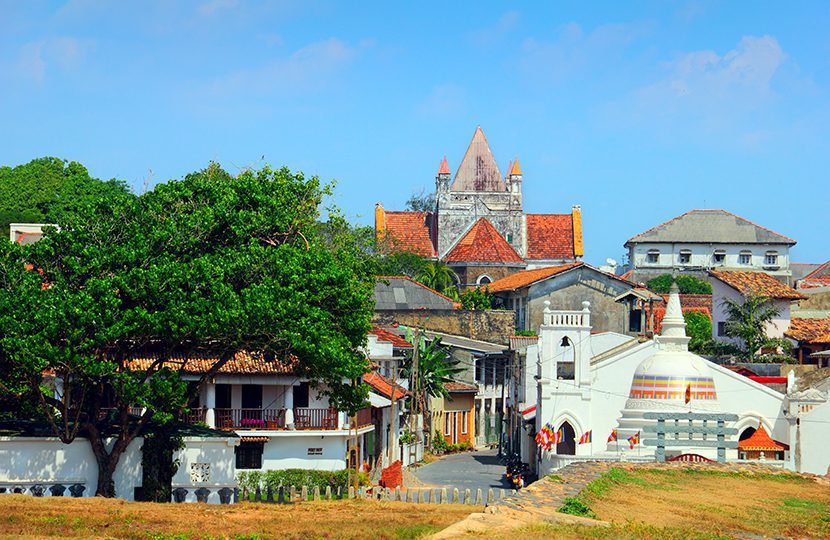It may help if I tell you that down on the South coast, it is hot from December to March.
[vc_row][vc_column width=”1/4″][vc_separator color=”black” border_width=”10″][vc_custom_heading text=”A wonderful drive through stunning, diverse landscapes of Sri Lanka, one moment there were hills and jungle, the next paddy fields”][vc_separator color=”black” border_width=”2″][vc_widget_sidebar sidebar_id=”sidebar-page”][/vc_column][vc_column width=”3/4″][vc_column_text]
It may help if I tell you that down on the South coast, it is hot from December to March. In April and May the monsoon rains and stormy seas come, and the scene shifts to the heat of the East coast, around Arugam Bay. Then people move back to the South coast again. In the summer months, it can get a little more humid and rainy but there are some beautiful sunsets and the central part of the southern half of the island (known as the ‘tea country’) tends to be cooler than the coastal regions.

Beautiful beaches of Sri Lanka
And so onwards from Colombo airport and down south I venture, onto Tangalle on the coastline that meets the Indian Ocean and directly beyond which there is no land for thousands of miles until you get to Antartica. I had a wonderful drive through stunning, diverse landscapes. One moment there were hills and jungle, the next paddy fields where strikingly thin and brilliantly white ibis birds pecked at worms and appeared in blissful harmony with their neighbours, the buffalo who even have the distinct word ‘gokuradiya’ for their action, meaning the water in a hole made by its hoof.
I felt a real delight in witnessing the source of my food as workers, up to their knees in mud in the paddy fields, left behind them immaculate rows of rice. And to taste their rice that evening made me appreciate my food all the more. Sri Lankan cuisine is typically wholesome and healthy featuring a wealth of spices and flavours. Like the subcontinent, typical meals consist of colourful curries (eggplant, potato, green banana, chicken, fish). These come with rice and roti, string hoppers (steamed rice noodles), kottu (a carb-heavy diced roti dish, often served with vegetable, eggs or chicken), and pittu (a mixture of flour and coconut).
The seafood includes fresh fish from the ocean and prawns, crab, squid and crayfish. Dessert specialities are buffalo curd eaten with palm-honey and the Malay-derived caramel-like wattalapam. And of course there are the usual succulent tropical fruits of mango, pineapple, banana and papaya. There are also the locally known mangosteen, king coconuts (known as thembili), woodapple, which can be quite bitter and custard apple.
I visited some old English friends of mine who had realised their dream by buying a plot of land, building a house, planting some fruit trees and selling the proceeds of their cinnamon crop. From their hilltop I could see the coastline and hear the competing sounds of Buddhists chanting and Muslims called to prayer and smell the fruits of their orchard. Quite a special sensory overload. It really made me sit up and question whether away from the Tropics I could really realise my own dream.

Railway station Unawatuna
As for the amazing range of wildlife, well there’s music in the jungle. Especially with the dawn chorus. Colourful birds abound, peacocks strut upon their stage while fireflies shine out like mini stars and I was soon a twitcher, straining to spot the cormorants, eagles, kingfishers, blue pigeons and grosbeaks. I also discovered iguanas, mongoose, giant squirrels and the mighty, waddling monitor lizards. The natural habitat consisted of mango trees, rubber trees and the vibrant bougainvillea and the kithul tree the locals use to make jiggery, a sweet honey like maple syrup but with an interestingly smoky taste.
I took the most wonderful of all walks down through the village where I felt all of the island’s innocence and timeless charm. Dogs sit out by day to protect the houses and lie on the road at night to enjoy the tarmac’s warmth. A row of houses awaits the sound of ‘Fur Elise’ that heralds the bread truck or was it for ice cream? A multicoloured school bus goes by. Schoolgirls in their white uniforms have thick platted hair that descends beyond the top of their legs. A washerwoman by the stream thinks twice about agreeing to be photographed amongst her laundry. Elderly ladies parade in pairs beneath their vivid-coloured parasols. Old men stick their legs out at right angles on old colonial bicycles that cause them to adopt staunch, upright postures.
I reached my destination, the famous 2,300 years old Royal temple at Yatagala. It is here that there is a legendary ancient tree that came from a sapling of the Bodhi tree where Buddha once sat. It is surrounded by calm, cold caves and reached by a flight of 200 steps. Which is when I felt the real quality in the act of covering up, taking off my shoes and making a floral offering. Inside the temple, I followed the age-old paintings and statues that depict the story of Buddha, naively but clearly told and confident in its message. For Sri Lanka is indeed a multi-religious and multi-cultural society, endowed with a legacy of colourful festivals relating to the Buddhist, Hindu, Muslim and Christian religions. Every full moon day is a public holiday known as poya. I missed it very sadly by two days.
The lovely crescent beach at Unawatuna has beautiful yellow sand but is sadly swamped by tourism. I managed to regain a sense of peace at the nearby Japanese pagoda with its pure white paint offset on all four sides by gold statues. It has an impressive 360 degree view of the jungle, the bay and the Galle Fort I was soon to visit. I got a great sense of innocence at the local railway station that is a wonderful throwback in time with old-fashioned timetables behind glass frames and I would love to have had time to be a passenger snaking through all that wonderful landscape.
As soon as I stepped outside my hotel at Galle I felt immersed in this extraordinary colonial outpost. It was the lure of the highly profitable trade in spices and gold that had drawn the Europeans. First the Portuguese in the 16th century and then the Dutch and English in the 17th. The name Galle is attributed to a Portuguese mariner who was first to spot the natural harbour in 1505, when they were blown off course heading for the Maldives. He is said to have seen a cockerel and shouted out from his crow’s nest “galla buonvista”, Portuguese for “a cockerel, what a beautiful sight”.
With fourteen massive bastions, a grid system of streets, and original Dutch bungalows, Galle has a different vibe from the Sri Lanka I had come to know and love. Quiet at night and a tourist trap by day for shoppers keen to haggle for gems, as well as find traditional designs such as makara (a mythical animal, lion, swan, elephant and lotus) along with ritual masks, lacquer ware, batik and handloom textiles, lace and wood carvings.
Just outside the fort at Galle I just had to pop in on what for me is one of thirty odd Meccas around the world, namely a Test Cricket ground. Unusually underdeveloped with at least half the ground lacking seats, it still allows for spectators to look on for free from the ramparts above. It is bang next to the famous fruit market with its yards upon yards of bunches of bananas.

Jetwing Lighthouse – Dutch Suite
In 1850 there used to be a 45 minute pigeon post all the way from Galle to Colombo, flying at some 85mph, established by The Observer newspaper. Even with the new motorway, it was bound to take me a little longer to reach the capital. Transport has its own challenges even now with the right of way always open to question. So renting a car would not be my suggestion. Tuk-tuks are fun to take and breezy especially on the minor roads. While dishing out advice, I stress you just have to respect the midday intensity of the sun and likewise the savage currents of the Indian Ocean.
I picked up a copy of the Sinhala dictionary, the language spoken by the largest (roughly 15 million) ethnic group in Sri Lanka. It has some wonderful vocabulary, especially those alluding to physical characteristics such as ‘kadadat’ meaning to possess only half of your original teeth; ‘khuranásá’ for one having a nose like a horse’s hoof; ‘tivili’ for a person with three dents in his belly (from fatness) and my favourite ‘miyulesa’ for a woman with the eyes of a deer.
Michael Ondaatje, the famous contemporary Sri Lankan author explains why the letters of the language have no jaggedness. “While Sanskrit is governed by verticals,” he writes, “its sharp grid features were not possible in Sri Lanka. Here the Ola leaves that people wrote on were too brittle and a straight line would cut apart the leaf. So a curling alphabet was derived from its Indian cousin”. Unlike other popular tropical destinations, Sri Lanka remains
relatively untouched and unspoilt. The war is finished, the tsunami is a decade past and the highways now connect the island efficiently.
With tourism rates projected to explode over the next few years, now is the perfect time to visit. ‘Ayubowan’ is their word for every form of greeting stretching from ‘good morning’, ‘good afternoon’, ‘good evening’, ‘good night’ to ‘good-bye’. Ayubowan! ◼
Subscribe to the latest edition now by clicking here.
© This article was first published in Apr-May 2017 edition of World Travel Magazine.
If you would like to comment on this story or anything else you have seen on World Travel Magazine, head over to our Facebook page or message us on Twitter.
And if you liked this story, subscribe to our bi-monthly World Travel Magazine, a handpicked selection of editorial features and stories from Global Destinations, Inspire Me, Insider, Style File, Wellness & Travel, City Travel, Suite Life, At Leisure, Short Breaks and much more.
[/vc_column_text][/vc_column][/vc_row]




